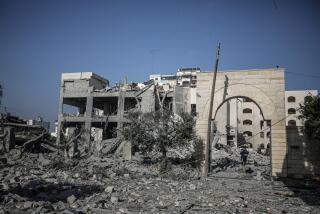Culture : Hermitage Sinking Under Lax Security : Russia’s famous art museum is pillaged by vandals and workers alike and undermined by riverbank soil.
ST. PETERSBURG, Russia — One of the world’s greatest museums was nearly destroyed a few months ago by a forgotten cup of tea.
A worker in the fabric section of the Hermitage’s Russian History Department had plugged in an electric tea kettle but then forgot about it. The water boiled away, the kettle burned up, the curtains caught fire, and suddenly the Hermitage--home of Rembrandt and Rodin, Matisse and Manet, Scythian gold and Egyptian sarcophagi--was in mortal danger.
The alarm and sprinkler system wasn’t yet fully installed--it still isn’t--so no warning sounded as flames crept closer to a dress owned by Czarina Catherine the Great. Smoke pouring from the window finally alerted a passerby; luckily, he was a former museum security officer and knew whom to call. Museum firefighters quickly put out the blaze.
The half-finished sprinkler system did eventually work, but for no good. It kicked on without cause one night, pouring more than 100 tons of water into the newly restored Hermitage Theater.
Both events underline what many specialists here call a disgracefully lax security system for the Hermitage’s wondrous 3-million-piece art collection.
Perhaps just as alarming about the two mishaps is how the museum’s leadership reacted.
For Alexander Baturin, head of security at the Hermitage, the fire is proof that all is working wonderfully. Baturin proudly states that “one of our guys” noticed the smoke and called it in smartly.
Mikhail Piotrovsky, director of the Hermitage, has a different take. He accuses the press of sensationalizing the fire. Never mind that the incident has been mentioned in print just once in Russia, at the bottom of a 39-paragraph story in the St. Petersburg Bulletin.
As for the sprinkler malfunction, well, Piotrovsky explains, that’s Finland’s fault. The sprinkler system is Finnish-made and Finnish-installed, he says, “so this has been a lesson to us, a reminder that the West brings us as much bad as good.”
Others concerned about security at the Hermitage say Piotrovsky shoulders much of the blame himself. The testimony of current and former museum workers, police officers and cultural officials suggests that--despite its proud history--the Hermitage is no longer capable of caring for its treasures.
*
The Hermitage is a complex of stately buildings strung along the banks of the Neva River. At its core is the czar’s 535-room Winter Palace. In summer, about 30,000 people a day wander down its miles of halls to view one of the world’s finest collections of Western painting.
The museum was founded in 1764 by Catherine the Great, who collected European art for her “hermitage”--a cozy, private room closed off from the rest of the palace. Later the Bolsheviks swelled the museum’s assets by nationalizing hundreds of private collections after the 1917 Revolution.
Famous for its Rembrandts, the museum also boasts at least 25 major works by Henri Matisse and 30 by Pablo Picasso. Many of those works hang in direct sunlight, fading. Although in czarist days sunlight was filtered with colored paper glued onto the Hermitage’s windowpanes, not even that primitive precaution is taken today.
The museum also lacks air conditioning, and in summer the upper-story windows are thrown open. Paintings are exposed to cool breezes thick with humidity from the bordering Neva River and car exhaust from nearby Nevsky Prospect.
Basements are undermined by flooding and long-forgotten tunnels and drainage systems, some 250 years old.
“Do you feel how damp this wall is?” asked engineer Tatyana Yakusheva during a tour of the subterranean rooms and corridors. “Think about it: This humidity creeps upward along this wall to the pictures above. Meanwhile, this wetness--these stalactites, pools of water, this damp air--it’s eating away the foundations.”
The Hermitage is actually sinking, at a rate of a half-centimeter a year, into ground that grows more sodden with the passing of each season.
The Finnish government has promised to help with $100,000, while the Hermitage has put up $120,000 for Yakusheva to solve the water problems. Moreover, the Dutch government, in an agreement brokered by UNESCO, has pledged the Hermitage $1.2 million over the next 10 years for modernization and repairs.
“But although that sounds generous and impressive, most of that money is just a promise for now,” Yakusheva said. “This is a project that can’t wait for paperwork.”
Then there is that security problem.
Guards stationed in the display halls are almost all elderly women; the salary is too low to attract anyone else. Some doze at their posts while vandals pry crystal and metal details off the luxurious furniture.
In October 1992, when two 18th-Century crystal flagons worth $18,000 each were stolen from a display cabinet, it was a visitor to the museum--not an employee--who first noticed. Last summer, when auditors from the Ministry of Culture removed a painting from the wall, intentionally tripping the alarm, no one arrived to check on it for eight minutes.
The previous known major theft at the Hermitage occurred in 1991, when a marble sculpture of Dionysus, valued at tens of thousands of dollars, disappeared from its display case. Police discovered the statue in the baggage check room of Vitebsky Train Station, and the thief--a recently hired security guard--was arrested.
*
Yulia Andreyeva, a crime reporter for the St. Petersburg Bulletin, has catalogued dozens of petty thefts, the latest being the disappearance of a crystal pendant from a chandelier in the exhibit called “The Century of Catherine II.” The reporter is aided by letters from the museum’s ardent fans.
One letter was signed E.M., who has led tours at the Hermitage for 19 years. “In the Ministerial Corridor of the Winter Palace, bronze details have disappeared from the marble figures,” the letter says. “There are some large mosaic cabinets there, and medallions have (also) been pried off and stolen from them. Once security guards stood there, but not today.
“It’s the same in the Rembrandt Hall. There’s a chair on the left coming into the room. There were medallions of (different) types of stone (on that chair); now there are hardly any left.”
Officers of the Dzerzhinsky neighborhood police precinct, where the Hermitage is located, have urged the museum to tighten security.
“The facts show that in the Hermitage the security regime is flagrantly violated by the very people charged with guarding the museum,” they wrote in a report last April to Piotrovsky and the Russian government. “There is an absence of necessary control by the (museum) leadership for discipline. If the faults noted above are not hereafter eliminated, the theft of valuables will continue.”
Piotrovsky’s reaction to the report was curt.
“The police should search for thieves. That’s their job. As to what we should do, that should be indicated by a special commission” of the Ministry of Culture, he said.
Such a commission audited the museum recently. Among the recommendations: new policies on inventory and storage, a tighter museum pass system, better control over who has keys to various rooms and “development of the concept of ‘Hermitage Security,’ on the basis of centralized administration, strict division of duties and coordinated activity between all departments.”
What prompted such sweeping condemnation? Employees are tight-lipped--with the notable exception of Irina Printsova, a petite 59-year-old former security guard. Women of her generation make up the front line of the museum’s security system. Shod in bathroom slippers, often dozing in their chairs, they are stationed in almost every hall.
Baturin refused to extend Printsova’s contract because he wants to build a team of younger and more energetic guards. However, finding someone more energetic than Printsova would be tough. When Baturin, 62, fired her, she challenged him to a race through the Hermitage stairwells, with the condition that she could keep her job if she won. Baturin declined. Printsova is suing for her job back.
Workers at the Hermitage are horrified at how slack security has become, Printsova said, but are afraid to speak out.
“There’s so much unemployment in Russia now, and in the cultural fields unemployment is much, much worse,” she said. “At the Hermitage, people are clinging to their jobs in terror.”
*
Printsova, a self-admitted busybody, has documented her case against the Hermitage and intends to take it to UNESCO, which works closely with the museum. “While others went shopping, I spent my work breaks wandering the halls of the Hermitage, and if I saw something wrong I reported it,” she said.
“I saw other workers asleep at their posts, and I reported them. But they keep those people and they fire me. Why? Because I’m a nuisance. Because I don’t keep quiet and doze off in my chair.”
Three times, Printsova said, she has caught tourists creating a fire hazard by smoking around stacks of crates containing art. Other times, construction workers have been caught drinking on the job or in the museum after hours--a hazard to the sensitive renovations they’re doing.
“We write down in a journal who arrived when and who left when,” she said. “I’ve seen workers crawl out of here on their hands and knees. They’re so drunk they can’t even tell me their names. Once I wrote just that: ‘Too drunk to identify himself, left on hands and knees.’ No one ever read it. I don’t even know why we keep that book.”
More to Read
Sign up for Essential California
The most important California stories and recommendations in your inbox every morning.
You may occasionally receive promotional content from the Los Angeles Times.










